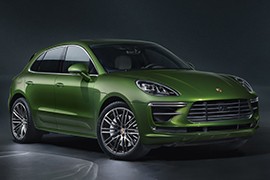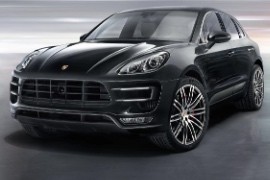PORSCHE Macan Turbo Models/Series Timeline, Specifications & Photos
First production year: 2014
Engines: Gasoline
Body style: SUV (Sports Utility Vehicle)
Porsche refreshed the Macan lineup in 2019, five years after the model’s introduction, and it also made a pumped-up version of it, worthy enough to get the “turbo” badge on the tailgate.
The German automaker developed the D-segment crossover Macan on the same MLB platform as the Audi Q5, but apart from that, everything was different, especially with the Macan Turbo variant. It could outperform many sports cars, and even if it had a smaller engine than the previous Macan Turbo, it offered more power. Like its stablemates that were refreshed for the 2020 model year, it featured an uprated interior and improved exterior styling. Furthermore, the automaker offered the car with
At the front, the 2020 Macan Turbo featured new headlights that integrated four LED blocks for the daytime running lights, similar to those installed in the Porsche Taycan. Underneath them, the automaker added two light stripes for additional DRLs on the bumper. Another significant improvement was for the bumper, which housed a broad center air intake fitted with a grille featuring horizontal slats and flanked by big scoops needed for additional cooling.
From its sides, the Macan Turbo didn’t show its true potential, but a keen eye for detail could notice the specific 20” alloy wheels and the massive brakes. As an option, Porsche offered a set of carbon ceramic discs grabbed by enlarged yellow calipers.
Finally, at the back, the Macan Turbo got a unique wing atop the raked forward rear window. Customers could open the electrically operated tailgate via a button neatly concealed in the rear wiper’s mount. Finally, four round exhausts peaked under the rear bumper, flanking the diffuser.
Inside, the 2020 Macan Turbo offered a luxurious cabin fit mostly for four passengers. At the front, the high-bolstered seats were standard. In addition, Porsche also offered a set of sports seats that provided additional side support and more adjustments. The redesigned dashboard featured a new 10.9” touchscreen for the infotainment system, while the center console housed as many buttons as Porsche could fit there and the gear selector. In the back, the split-folding (40/20/40) bench seat was suitable for two adults, but a middle-seated one didn’t have too much legroom at their disposal due to the transmission tunnel. Still, all car occupants could enjoy the 14-speaker Bose surround sound system, which was standard.
Under the hood, Porsche installed a newly developed 2.9-liter V6 engine. Thanks to its twin-turbo technology and the direct fuel injection, it could provide ten percent more power than the 3.6-liter turbocharged V6 that it replaced. Power went in all corners via a seven-speed automatic (dual-clutch) gearbox. The automaker also offered a height-adjustable air suspension and Porsche Torque Vectoring Plus adaptive transmission that helped the car corner faster.
The cross-over and light SUV market have expanded that much that even Porsche tried to take a piece of the mid-size premium market with its Macan model. And then, it added a Turbo version.
The Audi Q5 platform found its way under a Porsche SUV bodywork. Even if the manufacturer tried to sell the Macan as an alternative for the Cayenne, it was more like for those who were looking for a 911 with four doors and higher ground clearance.
The Macan took most of its outside details from the big Cayenne. The LED headlights, the greenhouse shape, and the rear tailgate are all from the same Cayenne design book. The rear 3D taillights are somehow similar too. Unfortunately, the weight is also very close to a 2-ton vehicle, which is not that good.
Inside, Porsche offered all the luxury needed for its occupants. Unlike other Macan version, the Turbo featured more amenities than the base models. The center console had some similarities in design with the Panamera. And, like the rest of the Porsche family, it doesn't offer an Android Auto connectivity. It has only Apple CarPlay.
Under the hood, the twin-turbo 3.6 liters V6 engine offered 400 hp. It was mated to a standard 7-speed PDK (dual-clutch) gearbox and an all-wheel-drive system. Its performances were good enough to grab the attention to someone who would like a 911, but need room for 4 passengers and the Panamera was too big.

